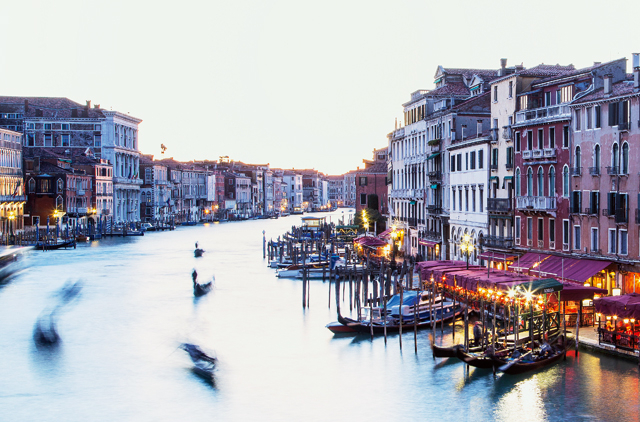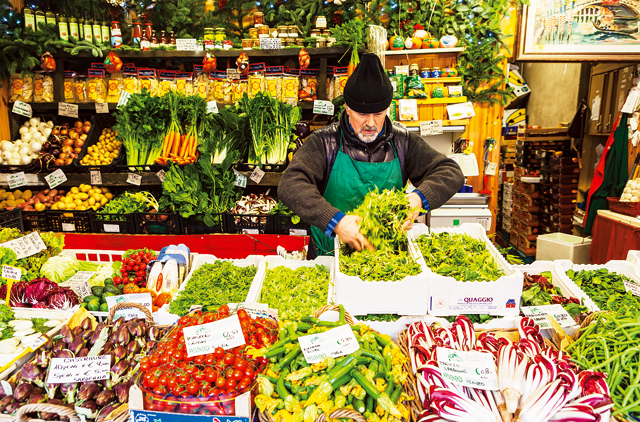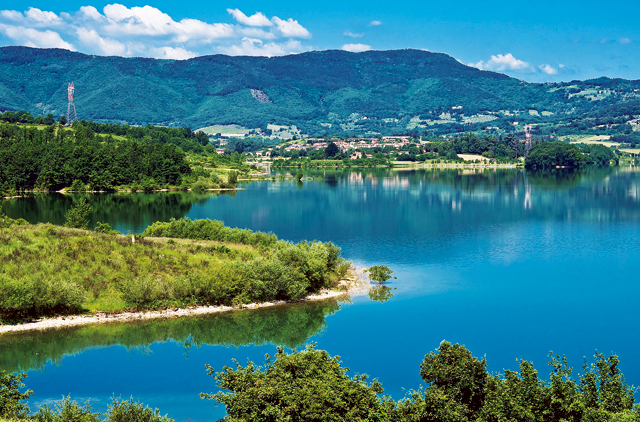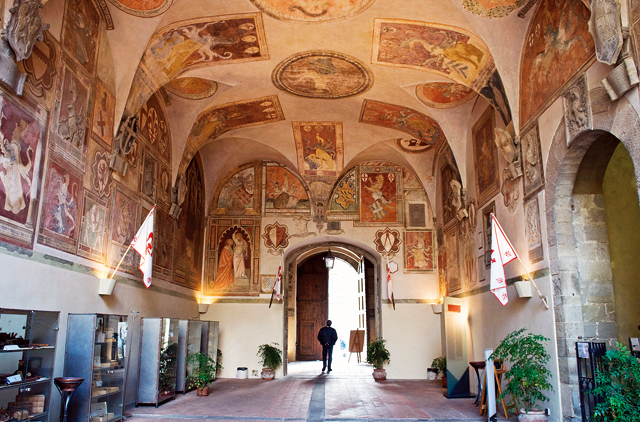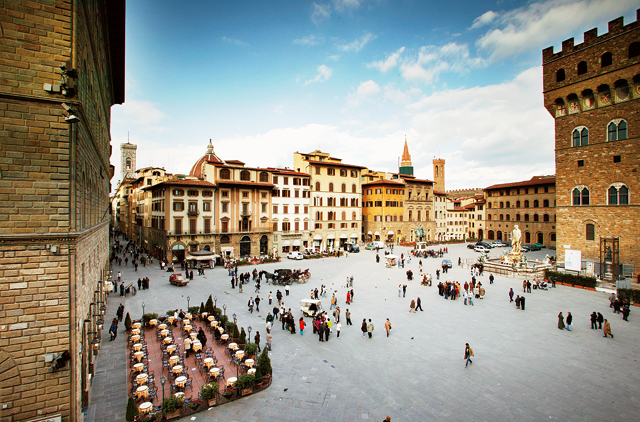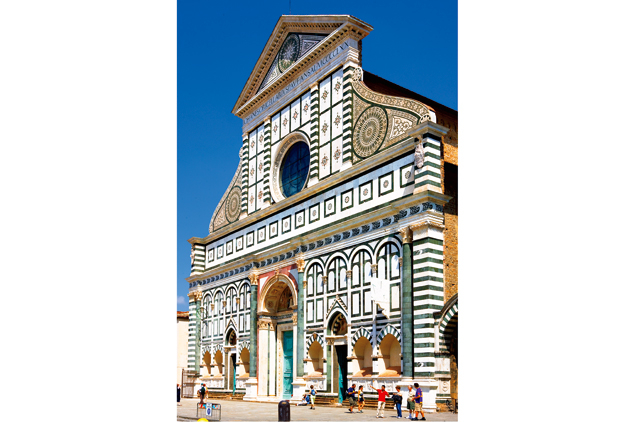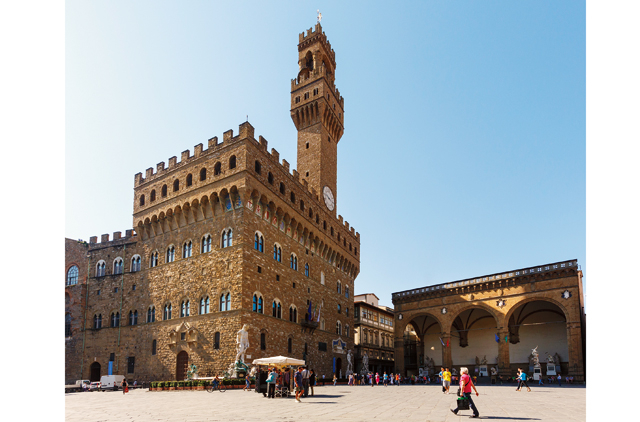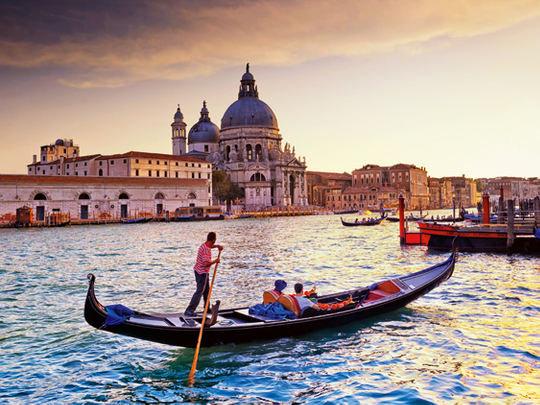
It’d been 24 hours since I landed in Venice and I still hadn’t seen a car or a road. “Everything here is done by boat, even garbage collection,” said Luciano Novena, Middle East area manager for water brand San Pellegrino. We were in a water taxi cruising along narrow canals on our way to Rialto Market to shop for ingredients, all set to cook up a storm in Venice.
It was very early in the morning, so when we arrived the market was quiet. We pulled out the shopping list and began trawling the stalls, picking up salmon from a fishmonger at a red brick hanger. Then it was on to the vegetable and fruit section; and to a deli to pick some choice cold cuts.
As locals began to trickle in to buy freshly baked bread for breakfast, we were already done and enjoying a cappuccino while marvelling at the architectural wonder that straddles the Grand Canal.
Built in 1591, Rialto Bridge stands on wooden pilings and souvenir shops now line the walkway below its iconic 7.5m stone arch. The handiwork of the aptly named Antonio da Ponte (Anthony of the Bridge) is the heart of Venice and a perfect spot for gondola watching.
Two hours later I was out at sea aboard a sailboat taking part in the San Pellegrino Cooking Cup, an event that brings together cooking and sailing enthusiasts from all over the world. With more than 50 boats competing in the regatta for various awards, there was a carnival atmosphere in the Adriatic Sea.
There were eight of us on the UAE boat and we had our eyes on the prestigious Young Chef Award, a category that put us up against nine chefs in boats from nine other countries across the globe.
On top of the world in Nepal
How a couple lost 70kg in a year
Feeding a hungry Mumbai every day
Easter Island: One of the world’s most remote places
Chef Dominic Perzold of The Westin Dubai Le Méridien Mina Seyahi Resort and Marina was representing the UAE using the ingredients we’d bought at the market earlier. But the competition was all about teamwork – the crew sailed the boat through the 16km race, while the chef cooked, and at the end points earned from both cooking and sailing would determine the winner.
We bobbed around eagerly awaiting the signal to start. The winds picked up. Finally the race began, along with the cluttering of the crockery as Dominic turned the sailboat cabin into a five-star kitchen. I watched his nimble fingers move deftly as he prepared the salmon fillet and chopped vegetables.
After a while I went out on to the deck to join the rest of the crew. Watching boats slicing the sea, the smell of the salty water was so strong I could almost taste it.
At first the water sparkled with a rare clarity, inviting me to dive in and cool off from the searing heat. But 30 minutes into the race the wind got even stronger and all I could see was a vast expanse of choppy waters. I began to feel light-headed and chewed some medicated gum to ward off sea sickness.
It worked, but then a few minutes later when the wind changed direction, our boat tilted precariously and did a 45-degree turn to the left.
I sprang into action. We pulled the ropes to adjust the sails. This was far from child’s play – the ropes dug into my palms painfully, but the thought of pans sliding off the stove in our makeshift kitchen gave me the power to hang on.
Although it wasn’t smooth sailing all the way, we managed to cross the finish line somewhere in the middle and presented our delicious-looking salmon tartar to the judges. Not bad at all considering the blustery sailing conditions, and although we didn’t win, we were all proud of our achievement.
A floating city
In the evening a water taxi took us from the Hilton Molino Stucky Hotel to Teatro La Fenice (Theatre of the Phoenix) for a gala dinner and awards ceremony. As the boat wove its way towards the venue, I was charmed by the beauty of the floating city, replete with stone buildings rising from narrow canals.
Dinner was an elaborate affair – a five-course menu paying tribute to Italian opera. Then the icing on the cake: an opera performance including Puccini’s Madama Butterfly and Verdi’s Rigoletto. The acoustics were excellent, proving that even though the theatre has been destroyed by fire several times since it was built in 1792, like the mythical bird it is named after, it always rises from the ashes.
On our way back, we hired a gondola. Clad in black trousers, a striped shirt and a fancy hat, the gondolier serenaded us as he steered us along the Grand Canal, the city’s main thoroughfare. After going under two bridges, he turned into the back canals, all the time singing and pausing only to show us iconic landmarks and share interesting morsels about the city.
Did you know that Venice has 118 islands, 177 canals and more than 400 bridges with poetic names like Bridge of Sighs, Bridge of Miracles and Bridge of Sails? I was impressed.
Back at the hotel, I went up to the rooftop swimming pool, which offers scenic views of the harbour and a bird’s-eye view of the city bathed in night light. Looking at the berthed majestic cruise ships across the shimmering canal and then at boats zipping and zooming along the waterways had me gaping in wonder.
Back on dry land
In the morning I was in for another treat, as I opened the window and was greeted by a cool breeze. I stuck my head out, craning my neck over flowers hanging from the balcony, and that is when I saw it – an orange ball rising over the sea. The sparkling water reflected its rich red and orange hues, creating a postcard-perfect picture – an awe-inspiring and memorable sunrise.
This spectacular visual feast set the tone for the day. After breakfast we took a water taxi to the bus station, where we were going to board a luxury coach to Tuscany. Three days after arriving in Venice, this bus was the first land vehicle I’d seen in all my time there. As it pulled out of the parking lot, I felt weird – probably the side effects of bobbing in water for days. But as it sped on the highway, I recovered my equilibrium and enjoyed the ride.
After making a brief pit stop in Modena to check out the Enzo Ferrari Museum, we finally arrived in Tuscany in the afternoon.
The scenery was totally different; olive groves, wheat fields, forests and rolling hills stretched as far as the eye could see. I immersed myself in Tuscan nature, gastronomy and culture – not necessarily in that order.
The journey began with water tasting at UNA Hotels & Resorts, Mugello. Yes, you heard right, water tasting, which was conducted by Andreas Larsson, a Swede nominated Best Sommelier in the World in 2007. I learnt something that my science and geography teachers never taught me: like wine, water has a terroir – a character of flavour, mineral and pH content etc that’s determined by the site of its source.
Next up was a traditional dinner buffet under the dazzling skies by the pool area. I put my newly acquired knowledge into practice. Channelling the water connoisseur in me, I washed down the protein-rich treats from the barbecue with San Pellegrino sparkling mineral water – its high acidity, I was told, helps to digest protein faster and aids in the absorption of nutrients – and when I moved to the cheese ravioli, I complemented its creaminess by switching to the smooth, velvety Aqua Panna. It really made a difference and the food tasted better.
Tuscany served up amazing gastronomic delights including a delicious ‘chicnic’ – an upscale picnic – at Villa Panna, which once belonged to the Medici family, one of the wealthiest and most influential families in Florence.
The cream villa is nestled amongst beech wood and chestnut forests, and lush meadows on the slopes of Mount Gazzaro in Mugello. The natural spring that’s named after the villa is located 900m above sea level on the ancient route connecting Florence and Bologna. In years gone by, travellers used to stop there to quench their thirst; later it was appropriated by the Medici family for their personal use, and now its water is available to millions across the globe in the form of Aqua Panna.
Then I had a taste of the Renaissance era when I sampled what Tuscans used to eat 500 years ago – fresh tomatoes and extra-virgin oil bruschetta for starters; roast potatoes and a thick slab of Fiorentina Chianina steak for mains; and Prato’s peaches for dessert. The Palazzo Vicari, Scarperia, a palace built in 1306 that has been converted into a museum of knives, was a befitting venue for the meal.
But I was also transported into the future and got a taste of things to come, literally. Chef Davide Scabin, patron of the avant-garde Combal.Zero restaurant, Turin, has devised Combal Space Lasagne, a dehydrated dish designed to last for 36 months, which will be given to Nasa astronauts to take to space for testing. A total of 26 dishes were served as part of his innovative, futuristic menu, which included the likes of virtual oyster (made from almonds and dried tuna) and cyber eggs (caviar wrapped in cellophane).
With all the eating I’d done, I had to balance things out by burning as many calories as I could. The hotel has an amazing fitness centre, but I chose to explore the surroundings and soak in the natural environment instead. Each day began with a long nature walk. A five-minute drive from the hotel took me to a lovely trail that begins at Villa Panna and leads into the woods.
Once a hunting reserve for the Medici family, the estate still has a lot of wildlife – I came face to face with deer, pheasants, a hare and a fox. The sound of gushing water from swiftly flowing streams cutting across the trail soothed my senses as I walked under a canopy of oak trees. Listening to the sounds of nature – birds calling out to each other and buzzing bees at work collecting nectar – and smelling the sweet scent of flowers wafting through the air brought peace. All the reason to keep going back.
Cultural surprises
I was already immersed in Italian culture, but there were more surprises in Florence, the capital of Tuscany. The city, which lies in the valley of River Ano, was teaming with goggle-eyed tourists, excited to be strolling around Dante’s birthplace after the success of Dan Brown’s Inferno, which was inspired by Dante’s poem of the same title.
I took a city walk, which began at the Santa Maria church with its opulent marble decoration and the 11th-century Baptistery of St John, where Dante – who was born a few blocks away – was baptised.
We wound our way around cobbled streets taking in Italian Gothic-style architecture until we reached the Piazza della Signoria, home to Florence’s iconic monuments including the prominent Palazzo Vecchio overlooking the square and the Piazza Villa Signoria, which was a palace in the 1500s and has been converted to a town hall, mayor’s office and part museum. Boasting 500-year-old original works of art, it is said to be the best sculptural museum in Italy.
We walked across the 700-year-old Ponte Vecchio bridge spanning the Arno River. Unlike Brown’s Harvard professor Robert Langdon, who made a quick exit through the Vasari Corridor to elude his enemies in Inferno, ours was a leisurely stroll.
On the other side is Palazzo Pitti, which once served as a residence for the Medici family and other Grand Dukes of Tuscany and houses many famous paintings. You get to see works by the likes of Raffaello, Michelangelo, Leonardo and Bosco all under one roof.
From the Palatine Gallery, I could see the beautiful sprawling Boboli Gardens, an open-air museum of sorts, which also features in Inferno. It provides a perfect setting for the gripping chase, I could picture Langdon and Dr Sienna Brooks’ escape through the pathways, past the fountains and grottos.
Unfortunately I couldn’t live in Professor Langdon’s world forever, and I had to go back to reality. But what remains is that I went, I saw, I ate and was impressed by Italy’s amazing treasures. I’ll always cherish the memories of my Adriatic and Tuscan adventures.


